|
INTRODUCTION
The 2015 BSS Conference was held over the weekend 10-12 April
2015 in the East Midlands
Conference Centre (shown above left) with accommodation in the nearby,
eco-friendly, Orchard Hotel (above right), in Nottingham. Operating in the usual format it commenced on the Friday
afternoon and finished after lunch on the Sunday. Set in 330 acres of
landscaped parkland, yet only 2 miles from central Nottingham, it’s a very
modern venue, with a contemporary look. Whilst not being an all-in-one-venue
conference, the organiser had promised that it would be much less of a problem for
delegates to walk between the buildings than was the case either at
Edinburgh or Greenwich. That was indeed the case though delegates who would
have liked
to go into other parts of Nottingham had a considerable walk to undertake even
to reach a bus stop.
The Conference Centre has 21 flexible meeting rooms – and is a venue which can
hold more than one meeting at a time - with a maximum capacity of 850 persons.
There is up to date audiovisual equipment and free Wi-fi throughout. Sadly
the audio facilities were not up to scratch and many delegates complained of not
being able to hear the presentations well enough.
Accommodation was at
the quite 'futuristic' Orchard Hotel which offers floor-to-ceiling windows,
bespoke furniture and unique décor
throughout and comes complete with free Internet and iMac access. Only opened in
2012, the Orchard Hotel includes a business lounge, 120-cover restaurant, bar
area, outside terrace, gym and four meeting rooms of its own. Its facilities included:
Facilities advertised
by the De Vere Venues 'Orchard Hotel':
-
Outdoor Terrace
-
Activities
-
Fitness centre
-
Food & Drink
-
Restaurant, Bar, Breakfast in the room
-
Internet
-
WiFi is available in all areas and is free of charge.
-
Parking
-
Free private parking is possible on site (reservation is not needed).
-
Room service, 24-hour front desk, Luggage storage, Business centre
-
Newspapers, Safety deposit box, Non-smoking rooms, Facilities for disabled
guests, Lift, Heating, Non-smoking throughout
-
Check-in from 14:00 hours
-
Check-out until 11:00 hours
 REGISTRATION REGISTRATION
In the announcement of the conference, bookings were requested by March 4th 2015. A paper
booking form was distributed to BSS Members with the
March Bulletin but a copy could be downloaded from the BSS web site as a PDF
here.
Rates & Payment
Package for the conference Friday to Sunday, including joining pack,
lectures, a conducted dial tour, two nights en-suite accommodation and all meals
and refreshments:
Single room en-suite - £330
Double room en-suite - £520
Extra nights (single or double room) before/after conference - £70/night
Day Delegate Rate including all the above except accommodation and
evening meals £120 pp. Add £45 pp to attend the Conference Dinner.
Payment was arranged to be made by cheque or funds transfer or by using PayPal or by credit cards here.
A Bank transfer could be made directly to:
Co-operative Bank PLC, 1 Balloon Street, Manchester, M60 4EP, SWIFT code CP BK
GB 22,
Sort code 08 92 99, Account name: The British Sundial Society, Account no. 6573
3095.
Due to the variety of options for accommodation and meals,
delegates used
the conference booking form to register and to calculate the amount of the fee.
After payment had been made the completed conference booking form was then be returned
to the Conference Organiser.
For cheque payments the form was then sent with the cheque.
As
always, BSS invited members to bring dials and related objects to show to other
delegates.
An odd idea which had first started at Greenwich was for
delegates to be asked to bring a sundial-related cake. In what was
clearly seen by others as a move away from the academic principles of the society's
conference, the trustees decided to repeat this. Delegates had therefore been
asked to use their imagination, design and prepare a cake and bring it for
judging and subsequent eating. However in the event it seems only two such cakes materialised. It is doubtful if such a
'dumbing-down' venture will be repeated.
In a welcome departure from previous practice (and one that
brings with it adherence to good charity practice at last) members of the public
who were not BSS members were able to register for the conference without
any surcharge.
|
|
|
 The
Programme The
Programme
The programme for 2015 was:
Saturday, 11th April
9:00 BSS Annual General Meeting
9:40 Frank King: The Sundial of Adventure: A New Enid Blyton Story |
| |
A description of the discovery and
ongoing restoration of the Barker slate sundial that used to be on
Enid Blyton's house. The dial has recently been donated to The
Beckonscot Model Village. |
|
| 10:20 David Payne: The Burlingham Walks and Sundial
Trail – an 8 Year Quest |
| |
Norfolk County Council operate and
maintain the Burlingham Walks around which David Payne has
arranged a Sundial Trail.
Several dials are already installed: a human analemmatic dial, a
cube, a polar and an equatorial dial. The latter is set in the Tea
Garden at Fairhaven Gardens.
These Dials are in addition to six mass dials which can be found
on churches in the neighbouring villages of Acle & South Walsham.
Altogether 13 Dials are therefore available to view.
Three further declining dials are currently planned to be
installed by 2016 on the 3 sides of a triangular prism at
another location to bring the total to 19 Dials.
SunInfo will be following this interesting project. |
|
| 10:30 Ben Jones: The Roadford Lake Sundial (Quite a
big sundial) |
| |
The story of a large horizontal dial
made from materials sourced entirely from within the county of Devon
and erected to celebrate the Queen's Diamond Jubilee. |
|
| 11:15 Johan Wikander: Octaval Hours and Common Hours in the Norwegian Middle Age |
| |
A description of a 17C horizontal
sandstone dial in Traksvag that is carved with both octaval and
common hours and apparently with lines to help in its painting. |
|
| 11:30 Doug Bateman: The Bromley House Library:
its Meridian Line and its connection with Nottingham's famous
mathematician, George Green |
| |
A pre-visit summary of the Bromley
House library, the Christopher Daniel book collection, its 1834
meridian line and some of its other items of interest. |
|
| 11:50 Piers Nicholson: The Sad Story of a Sundial -
With a Happy Ending |
| |
Piers designed a large horizontal
dial for the cycle charity Sustrans which has suffered from
vandalism, flooding from a nearby river, a failure of John Prescott
to turn up to declare it 'open' and from serious overgrowth by
vegetation. Attempts were started in 2014 to rescue the dial and it
is hoped that there will be further restoration soon. |
|
| 12:00 Tony Moss: A new BSS Universal
Horizontal Dial for UK and European Latitudes |
| |
A description of Tony's standardised sundial designs
for use anywhere in the UK and which may be downloaded from the BSS
website. |
|
| Then afternoon tours
to the Bromley House library to see a display including a photo of the
long gone Nottingham time ball, the meridian line and a replica P&G
heliochronometer, then to Green's Mill to see the Harriet James dial.
Following this a trip to the University campus Millennium Garden dial by
David Harber, a'new' Saxon style sundial on the School of English and a
plain horizontal dial. The party then returned for the Conference Dinner
at which David Brown summarised the Society's recent educational
efforts. |
| Post Dinner 1 John Lester: Meet Jeanie
Crowley – renowned for her sketches of West Country sundials. |
| |
Jeanie Crowley left an important and
unique collection of 181 drawings of sundials based mainly on her
many visits to the churches of Devon and Cornwall. John described
her diligent efforts to measure and record these dials. |
|
| Post Dinner 2 - David Brown: Marg Folkard -
Sundials Australia |
| A showing of a film Marg made of the entire
process of constructing a notable armillary sphere |
| Post Dinner 3 - Chris Lusby Taylor: A mean
time horizontal sundial |
| |
Sunday, 12th April
9:00 Discussion session on the BSS Bulletin |
9:25 Allan Mills: Dialling Instruments in
Holbein's painting “The Ambassadors”
|
9:55 Dennis Cowan: Scottish Obelisks and
the Kirkton Hall Project
|
10:10 Geoff Parsons: The Memorial Sundial
at Bosworth Field
|
11:00 John Wilson: Studies on a
Nottinghamshire Mass Dial (at Holy Trinity Church, Lambley)
|
| 11:10 Fred Sawyer: Resurrecting Canon
Pierre Georges |
| |
12:00 approx: The Andrew Somerville
Memorial Lecture given by Dr Leofranc Holford-Strevens, author of The
History of Time (OUP):
The Dates of Easter Through the Ages |
| |
| Conference ends |
----------------------------------------------------
|
|
 Delegates
send us their comments after the end of the meeting: Delegates
send us their comments after the end of the meeting:
These comments will be updated as more and more
delegates tell us their views and as a more representative summary is
established.
·
Only 62-64 delegates registered this year. Not only is this
very few but the absence of several senior and influential members of the
Society caused some disquiet.
·
 SunInfo has recently learned that
the lower than expected numbers of attending delegates has actually triggered
a penalty clause in the contract with the either the conference
authorities or with the hotel - or possibly both. If, on further
investigation, this proves to be true and it turns out that committed bookings
and the numbers of likely attendees had not been kept in synchronism during
the process of conference organisation, then that will constitute yet another
in a long line of BSS blunders. Not only that but using charitable
assets to subsidise a section of the membership may in itself be contrary to
charity law and be something which, under current rules, the society may need
to report to the Charity Commission. SunInfo has recently learned that
the lower than expected numbers of attending delegates has actually triggered
a penalty clause in the contract with the either the conference
authorities or with the hotel - or possibly both. If, on further
investigation, this proves to be true and it turns out that committed bookings
and the numbers of likely attendees had not been kept in synchronism during
the process of conference organisation, then that will constitute yet another
in a long line of BSS blunders. Not only that but using charitable
assets to subsidise a section of the membership may in itself be contrary to
charity law and be something which, under current rules, the society may need
to report to the Charity Commission.
·
The accommodation at the Orchard Hotel proved to be very good
and the standard was quite as anticipated. The food was also very good, only
let down it seems, by coffee served from a machine.
·
Possibly as a result of the late initial notice of the meeting,
the conference programme was felt to have suffered from having rather too few
significant contributions and rather too many short ones even though many of
these were interesting and the short format allowed more topics to be covered. Of
course, any programme
is 'at the mercy' of what is offered by presenters. As a result a few
delegates commented that the meeting was 'not really up to standard' or, even described it
as 'boring'. However to redress the balance somewhat, one delegate
felt that the topics covered were in fact well balanced and interesting and
that in general the meeting went well. Perhaps such a spread of views is
a sign of a conference that has tailored for everyone in some way.
·
The sound system in the lecture theatre area was, on occasion,
inadequate and was at all times, variable. Oddly, none of the usual back up
mechanisms for such things had been provided this time and so there was little
that could be done to alleviate this during the weekend meeting.
·
With only a few days to go before the start of the meeting, the
plenary lecturer, Dr Holford-Strevens, had had to cry off owing to illness.
After a similar problem some years ago it had become standard practice to make
some sort of provision for a back up speaker - someone who could be called
upon at short notice even if the topic of their paper was not novel. However
this year it appears that no such provision had been made for this eventuality
and so the meeting was instead treated to the conference organiser
having to interpret the planned speaker's notes. Sadly this proved to be something
which, despite a valiant attempt on the organiser's part, was judged by some as not very successful.
·
The few comments so far received on the matter suggest that Fred
Sawyer's paper was judged to be the best presentation.
·
The meeting opened with an exceptionally rushed AGM - the first
to be held under the new Constitution. Some delegates were troubled to see that
they were asked only to vote 'en-block' for the election of all members of the
next Council. In fairness only one name for each available position had been
put forward but, possibly contrary to charity requirements, delegates had
no opportunity to refuse their vote for any one proposed individual; it
was a vote for all or for none. Other concerns were that even after spending thousands of
pounds on legal matters associated with the setting up of the 'CIO'
(Charitable Incorporated Organisation) it now appears that the brand new
Constitution needs urgent reform. An independent investigation and study of
this is apparently to be planned by persons other than the trustees.
·
A unwelcome aspect of the meeting was the way in which the
trustees seemed to go out of their way to generate an atmosphere of suspicion
and secrecy in all sorts of ways. Rushing the AGM, insisting on en-block
voting, appearing to restrict input from the floor, not providing a special
slot for discussion of the 'Chris Daniel books' problem; except for an
eventual intervention by Chris himself (see below), moving a talk into a period previously
allocated to free time without enough notice, the revelation that nothing now
gets printed or passed without the approval of the Chairman and Secretary -
despite all trustees having equal legal status - and trustees being perceived
to be attempting to join or listen in - maybe even uninvited - on any significant
grouping of delegates. These were all noticed by delegates with dismay and at the bar there were
some complaints about the way that the Society
seemed to have been 'taken over' and it not being the society they had joined
and which had been so well chaired by Christopher Daniel. Sadly several
seemed disenchanted and a few even said that they did not think they would
come again.
·
Sunday started with a discussion about the Bulletin - the
society's most prestigious publication - in the light of John Davis standing
down as its most successful editor ever. Despite this role having always been
one for a single person with a single person's stamp and authority, the trustees are apparently struggling to maintain
production and the Chairman requested even more volunteers to assist and join
the increased team size that is now being envisaged as necessary to enact
greater trustee control over this publication. The Chairman made it clear
that papers would, from now on, be vetted more carefully; why this was
necessary when it never has been so in the past, was not made clear. In the light
of the editorial 'inadequacy' now being experienced following John Davis's
departure, and given a reduction in the number of submitted articles following
concern amongst regular authors at the possible introduction of editorial
interference, the Chairman announced to some surprise that it would now be
necessary to reduce the number of Bulletins per year from four to three and
further for there to be fewer articles in each edition. Delegates speedily
noted that apparently no reduction in membership fee was envisaged.
·
Concern about the governance of the Society was for the first
time even being expressed by the general body of Specialists, the very hub of
the society.
·
Once again no questionnaire was provided by which delegates
could rate their conference experience.
·
All in all a very worrying situation seems to prevail that lends
credence to the belief that the society is nowhere near the Secretary's recent
description of it as being 'Fit for purpose in the modern world'.
|
Long
Term future of the BSS Library assured.
BSS members will have noted the
recent and welcome change of heart by the Council of BSS Trustees that was
announced by BSS Librarian Nick Orders in the December 2014 Newsletter. In this the security of the BSS
Library was affirmed at last and the on-going commitment of the trustees to its support and maintenance was finally confirmed.
As a result of this BSS President
Christopher Daniel has decided that his loaned collection is not now at risk of
unauthorised disposal and accordingly at the 2015 Conference he confirmed his
intention to leave his valuable works at the BSS Library in Bromley House,
Nottingham.
As a part of that address Christopher
disclosed that he had asked Frank King, as Chairman (and Chris Williams, as
Secretary) to put their signatures to the document to endorse it.
Churlishly in the circumstances, it
seems they refused to do so. Members will not understand this
extraordinary attitude.
A few copies of the donation document
were circulated at the conference - see this copy below.

|
Christopher Daniel announces his New Book!!
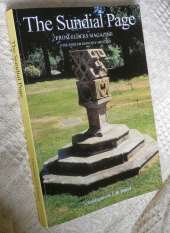 At
the 2015 Conference Christopher Daniel showed delegates a proof copy of
his new book. This is a compilation of all of his many contributions
to the 'Sundial Page' feature of Clocks Magazine that had
originally been started by Noel Ta'Bois. At
the 2015 Conference Christopher Daniel showed delegates a proof copy of
his new book. This is a compilation of all of his many contributions
to the 'Sundial Page' feature of Clocks Magazine that had
originally been started by Noel Ta'Bois.
This new work contains all 244 articles that were
written monthly by Christopher over the twenty year period 1988-2008.
Once again, Christopher's dominance of the UK dialling
world is evident with these authoritative articles that teach as well as
entertain those having an interest in time keeping over the centuries.
SunInfo will shortly summarise this most
interesting work. This is a very limited edition
but anyone seeking to purchase a copy should contact Elspeth Hill on
elspeth@malinriding.com for
further information. |
--------
Note: We strive to make sure that all comment here is accurate and
representative of the views that were expressed. Inevitably in areas where
only a few comments might have been received this summary might appear to
others as not reflecting the totality of opinions. The above commentary is
provided to SunInfo by delegates to the meeting and it will be changed
and adjusted to reflect a balance of all of the views received. If you feel
that any comment is unfair, unbalanced, insufficient or simply wrong then
please do let the webmaster know giving your input and evidence.
Info: 090415, 130415, 150415, 22.04.15 E & OE
|
A TYPICAL BSS CONFERENCE FORMAT
The previous BSS Conference took place in Greenwich in 2014 and in view of the
more distributed nature of that event, it was necessary to depart from what might
be called the normal format of BSS Annual Conferences. The Nottingham
Meeting promised to have a more normal format and for those who may not know of
this and especially for the convenience of newcomers, we placed a
description of a typical BSS Conference here on a separate page.
Click here: Typical Conference Format.
Come back to this page to continue to read specific details of the 2015 event.
LOCATION OF THE 2015 CONFERENCE
The East Midlands Conference Centre and the Orchard Hotel are
located within the grounds of the University Park Campus. The GPS Coordinates of
the Conference Centre are 52.938821, -1.203161. See the red circled
buildings on the marked up Campus plan below.
A PDF version of the actual Campus plan is available by clicking on the
University link -
HERE

GETTING THERE
A guide to how to get to the Conference Centre and the Orchard
Hotel was available
here courtesy of ARMA.
By Car
For those coming from the North, West or South of the UK the easiest
approach was from Junction 25 of the M1 and from there the A52 Brian
Clough Way as per the blue line shown in the map below (courtesy
Google Inc).
The journey by car was approximately 6 miles and takes 13 mins. For
those coming by car from the East drove to Nottingham City and
took the A52 from there to the University.

Car Parking was provided just to the North of the Conference
Centre.
Conference delegates and visitors could park there either in pay and display car parks
or in designated parking zones.
Advice to delegates on the PLACES TO VISIT WHILST IN NOTTINGHAM

I - The BSS Library
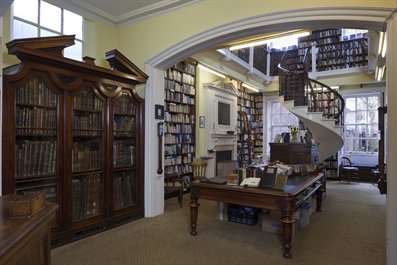 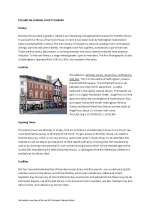
Without doubt the main item on any BSS Member's list for a visit
whilst in Nottingham has to be to the BSS Library in Bromley House!!
This not only contains the Society's extensive book collection but it also has
its own replica Pilkington and Gibbs
dial in the rear garden (SRN 4181 - restored by Graham Aldred in 2006) and the building even
possesses its own meridian line (SRN 3862)!
All BSS members are covered by a Group
Membership agreement at the library. This was negotiated at the outset at a very reasonable cost
which gives access to Bromley House and its facilities, to the BSS
Collection and any of the other Collections. Thus, BSS Members may not only enjoy the BSS
archived collection (complete with Chris Daniel's loaned collection) - and even free coffee!
Also when there you may peruse any of the other works and displays housed
there too. One of the more recent displays was their WWI exhibition (27
Oct - 17 Dec 2014) which gave library members the opportunity to see 'the best
exhibition in town' and see their 'staggering collection of expertly displayed
memorabilia'.
The 'replica' Pilkington & Gibbs dial in the rear garden was constructed by a former
'Friend of the Bromley House Library', R Clarke in 1992, as a copy of a
Pilkington and Gibbs design but with a slightly cruder interior construction and without
the lower
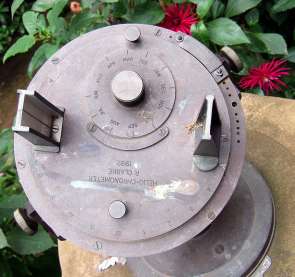 bowl
that is so
much a part of an original P&G dial. It is mounted on an 18thC pedestal. When it
was made it included an Equation of Time cam of somewhat doubtful accuracy and this was compounded by
it being fitted out of phase with the date selection,
so that if the month
of November was selected (for example) then the adjustment for February was applied, so the
inherent November ‘fastness’ was augmented and the dial read 16 mins fast, PLUS
14 Mins! Up until that time the then Bromley staff had believed that the dial had
always worked and told perfect time just as per a clock, though we now know that was not so. In his restoration, Graham Aldred remounted the existing cam so that its
adjustments were aligned with the date, but even then the cam itself was not
sufficiently accurately made. The dial therefore now remains as one with a small
'repaired fundamental error'
in its construction and one which has been restored to the best working state
achievable by its existing components. It is set accurately on the meridian.
Have a look and see for yourself just how accurate it really is. There is
some more information about (original) Pilkington and Gibbs Heliochronometers, courtesy of
BSS Member Mike Shaw,
here bowl
that is so
much a part of an original P&G dial. It is mounted on an 18thC pedestal. When it
was made it included an Equation of Time cam of somewhat doubtful accuracy and this was compounded by
it being fitted out of phase with the date selection,
so that if the month
of November was selected (for example) then the adjustment for February was applied, so the
inherent November ‘fastness’ was augmented and the dial read 16 mins fast, PLUS
14 Mins! Up until that time the then Bromley staff had believed that the dial had
always worked and told perfect time just as per a clock, though we now know that was not so. In his restoration, Graham Aldred remounted the existing cam so that its
adjustments were aligned with the date, but even then the cam itself was not
sufficiently accurately made. The dial therefore now remains as one with a small
'repaired fundamental error'
in its construction and one which has been restored to the best working state
achievable by its existing components. It is set accurately on the meridian.
Have a look and see for yourself just how accurate it really is. There is
some more information about (original) Pilkington and Gibbs Heliochronometers, courtesy of
BSS Member Mike Shaw,
here
Click on the above picture (left, above) of the interior of
this wonderful library to go to the Bromley House website and on the document
image (right, above) to see a short description of the Library and how to get to it.
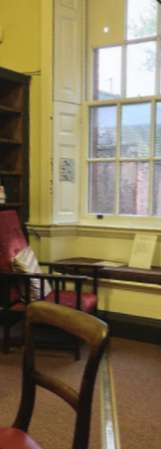
From its inception the library has been a
focus for scientific interests and relics of this reputation remain to this day. One such is the
meridian line which is unusual in that so few such still exist. The one at
Bromley House is on the first floor and takes the form of a brass strip set in
the floor in a true N-S direction, with a vertical extension at the far end up
to the top of the door frame in order to accommodate measurements of Noon in the
winter months. The necessary 'aperture', to provide the spot of light which
crosses the line at solar noon, was originally set in one of the wooden shutters of a window
at the southern end. The line is peculiarly recessed to permit a plumb bob to be
used during observations for reasons that are not entirely clear but may well be
connected with measurements of the diameter of the sun spot or to help establish the
sunspot position when it is off the ordinary scale. The meridian line
was installed in 1834 and was supported in its use by two long case clocks that are
still in the same room. The wooden shutter is sadly no longer in place, so a board
over the window is now used to demonstrate the operation of the line; as may
be seen in the small picture to the left.
The position of the meridian line (using Google Maps GPS coordinates) is N52°:57':12".6,
W1°:9':8".9 There is more about it and its discovery in a
BSS Bulletin Article by DA Bateman
here.
Another scientific aspect of the Bromley
Library relates to its role in early photography. Ask at the desk for more
about this.
Finally, before visiting, those interested
may peruse the Library's extensive catalogue from the comfort of their own computer,
here.
II - The dial at the Warden's House, Hugh
Stewart Hall
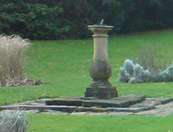 Another sundial exists in Nottingham itself. This is an
horizontal dial and is actually on the University campus, only a short walk from
the Conference. Another sundial exists in Nottingham itself. This is an
horizontal dial and is actually on the University campus, only a short walk from
the Conference.
It should be located 120m SW of the Warden's House, in the gardens of Hugh Stewart Hall
at 52.939476° N, 1.196305° W. It might still be taken in for safe keeping and
you may have to ask to see it.
The BSS Registrar would undoubtedly appreciate some more detail
about this dial.
III - Sundial Corrections for the period of the
Conference
|
Total 'Sundial Time to GMT' Corrections
applicable during the Conference |
|
[Figures after Smart, applicable at Noon GMT in Nottingham] |
|
9 April 2015 |
6m 26s |
Dial Slow |
|
10 April 2015 |
6m 10s |
Dial Slow |
|
11April 2015 |
5m 54s |
Dial Slow |
|
12 April 2015 |
5m 38s |
Dial Slow |
NB British Summer Time will be in force at the time of the Conference so a
further hour needs to be added when converting to current civil time.
IV - Other Nottinghamshire Dials
There are several other dials in the County of Nottinghamshire.
However the most unusually placed one must surely be the horizontal dial at the
top of Southwell Minster, 75 feet off the ground on the South ledge of the Clock
Chamber! It was used to regulate the clock. It is SRN 4197 and was first
discovered for us by BSS Member Tony Wood. Ask him about it when you are
at the conference.
Some of the known SUNDIALS of Nottinghamshire. (In order of Town, Location, OS
Grid Ref and SRN)
Averham St
Michael & All Angels' Churchyard, S of Nave
SK767544
Horizontal 4194
Blyth Sts
Michael & Martin's Church. Over South porch
SK625872
Vertical (S) 5351
Bunny Bunny
Hall
SK584296
Multiple 5910
Burton Joyce
North side of A612 through village
SK646437
Equatorial 4700
Carburton St
Mary's Parish Church on nave corner
SK611733
Multiple 2472
Cossall
Almshouses, on frontage
SK483423
Vertical (S) 4080
Cuckney St
Mary's Church
SK567714
Vertical (S) 0611
East Leake St
Mary's Church
SK552262
Vertical (D) 1368
East Leake BPB
Gypsum Ltd, R & D Dept
SK550260
Equatorial 2942
East Markham St
John the Baptist Parish Church
SK743727
Vertical (S) 1957
Egmanton Our
Lady's Church, on INSIDE wall
SK736689
Horizontal 4653
Holme
Pierrepont, Notti Holme Pierrepont Hall, in courtyard garden
SK620380
Horizontal 3981
Little Green,
nr Screveto St Wilfrid's Parish Churchyard
SK729434
Horizontal 1030
Newark The
Ossington PH, Beast Market Hill, Kelham Rd
SK797541
Vertical (D) 4021
Norwell nr
Newark St Laurence Churchyard
SK776618
Horizontal 1959
Nottingham
Bromley Subscription Library, Angel Row
SK575034
Equatorial 4181
Nottingham Hugh
Stewart Hall, University Horizontal 1883
Nottingham
Nottingham Subscription Library, 1st floor
SK570399
Noon mark 3862
Nottingham
(Private Dial) Equatorial 3861
Rampton Parich
Church, over porch
SK799785
Vertical (S) 4270
Ratcliffe on
Soar Power Station Tech HQ, at road side off A453
SK499295
Equatorial 3030
Southwell
Southwell Minster, Sth ledge of clock chamber
SK702538
Horizontal 4197
Southwell The
Workhouse [NT], Upton Road. Eof S wall
SK71-54-
Other 5740
Stapleford
Bramcote Hills Park
SK499385
Horizontal 5079
Sutton in
Ashfield Portland Square
SK485594
Horizontal 2955
Teversal St
Katherine's Church. On South wall.
SK483619
Vertical (S) 4610
Tollerton
Tollerton School, Burnside Grove, nr entrance
SK610342
Vertical (D) 4622
Upton Upton
Hall [1], on East Terrace
SK734544
Equatorial 4075
Upton Parish
Church, Church Lane. On Sth buttress
SK736543
Vertical (S) 4199
Upton Upton
Hall [2], in gardens to South of House.
SK734544
Equatorial 4074
Weston nr
Newark All Saints' Parish Churchyard
SK774680
Horizontal 1958
Worksop Clumber Park [NT] in garden by Lakeside SK626746 Horizontal 0612.
V - Some nearby Mass Dials
Here is a list of some mass dials known to be in the County. If you have time
why not explore a few of them? Of particular interest are those with Roman
Numerals.
In the abbreviated notes below 'agl' (where it occurs) stands for above ground
level. The SK number is the National OS Grid Reference and the LR number
is the Landranger map number.
Askham
2020 Church of St Nicholas
Averham Nave, SE
quoin stone LR120 SK740750
2021 Church of St Michael and All Angels
Barnby in the Willows RH porch buttress 1220 mm agl LR120
SK764549
2022 Church of St Michael and All Angels
Barnby in the Willows E end of S side 1905 mm agl LR120
SK764549
1061 Church of All Saints
Barton in Fabis Porch, to L of doorway. 860 mm agl LR121 SK860521
2023 Church of St George
Bingham Chancel, buttress by priest door 1680 mm agl LR129
SK522328
2024 Church of St Mary and All Saints
Bunny Inside S porch. RH jamb of doorway 1500 mm
agl LR129 SK707400
396 Church of St Mary Nave, S wall, E of door, buttress 3 1340 mm agl LR129
SK583296
397 Church of St Mary
Car Colston Nave, S wall, E of door, buttress 1 1210 mm agl LR129
SK583296
2025 Church of St Mary
Caunton To L of priest door 1600 mm agl LR129 SK721430 SK721430
2026 Church of St Andrew Chancel, to R of SW buttress 1480 mm agl LR120 SK745600
2027 Church of St Andrew S Porch, to L of doorway 1660 mm agl LR120 SK745600
2028 Church of St Andrew Inside S porch. To left of church door 1600 mm agl
LR120 SK745600
2029 Church of St Andrew
Clifton To L of priest door 1160 mm agl LR120 SK745600
2030 Church of St Mary the Virgin S wall. To L of 1st window to W of S porch
1725 agl mm
2031 Church of St Mary the Virgin
Gedling Tower, E buttress 1690 mm agl LR129 SK541348
SK541348
2047 Church of All Hallows
Girton S aisle, Eastern buttress, quoin stone 1100 mm agl
LR129 SK618425 LR129
2048 Church of St Cicilia
Granby Inside S porch. To R of doorway 1300 mm agl LR121
SK825662
2049 Church of All Saints
Hawton Tower, SW buttress, quoin stone 2100 mm agl LR129
SK751362
2050 Church of All Saints
Hidding Tower, S side, SW corner 1300 mm agl LR120 SK788512
2051 Church of All Saints
Hidding S wall, buttress 3010 mm agl LR120 SK788512
2052 Church of All Saints
Hidding S wall, buttress 1500 mm agl LR120 SK788512
2053 Church of St Luke
Hockerton S wall, to R of 2nd window to E of S porch 1640 mm agl
LR120
2054 Church of St Nicholas
Keyworth Nave, SE corner, on buttress 2120 mm agl LR120
SK716565
2055 Church of St Mary Magdalene
Kirklington To R of 3rd window to E of S porch 1420 mm agl
LR129 SK614309
2056 Church of St Swithin
Lambley S transept. On a carved stone set into the 1870 mm agl
LR120 SK679576 wall
2057 Church of the Holy and Undivided Trinity
Langford Chancel south wall. Hidden mm agl
LR129 SK63 1454
2058 Church of St Bartholomew buttress to R of S porch 1060 mm agl LR121
SK821591
2059 Church of St Bartholomew
Laxton buttress to R of S porch 1250 mm agl LR121
SK821591 Roman numerals
2060 Church of St Michael the Archangel
Linby N wall, NE facing buttress 1200 mm agl
LR120 SK722670
2061 Church of St Michael
Mansfield S wall of S Annexe. To lower R 750 mm agl LR120
SK534509
2062 Church of St Peter and St Paul North Collingham S wall mm agl LR120 SK540609
2063 Church of All Saints
North Muskham Top quoin to L of priest door 1500 mm agl LR121
SK830620 Roman Numerals
2065 Church of St Wilfrid
NorwellButtress to R of Priest door 1280 mm agl LR120
SK798587
2066 Church of St Lawrence
Nottingham Dial S transept., W buttress 2500 mm agl LR120
SK776618
2067 Church of St Lawrence
Nottingham Dial Inside S porch. On E wall by church door, 1500
mm agl LR120 SK776618
2068 Church of St Lawrence
Nottingham Dial INSIDE the church. On N wall, facing S mm agl
LR120 SK776618
2070 Church of St Mary Dial 'Beside the High Vestry door - deep dug 1800 mm agl
LR129 SK577397
2069 Church of St Peter
Nuthall Dial Tower, West face, N buttress, to LofW 2150 mm agl
LR129 SK573397
2071 Church of St Patrick Dial S buttress E end of Nave 1000 mm agl LR129
SK514445
2072 Church of St Patrick
Orston Dial Nave, S wall, 1st buttress 1750 mm agl LR129
SK514445
2073 Church of St Mary Dial Chancel, L jamb of priest door 1500 mm agl LR129
SK769412
2074 Church of St Mary Dial Nave buttress, 2nd to R of S porch 1200 mm agl LR129
SK769412
2075 Church of St Mary
Ratcliffe on Soar Dial Nave, N door (blocked), R jamb 750 mm agl LR129
SK769412
2076 Church of the Holy Trinity
Rolleston R side of S porch buttress, facing EAST 1400 mm agl LR129 SK494289
2077 Church of the Holy Trinity
Scarrington Quoin stone LR120 SK742525
2078 Church of the Holy Trinity Scarrington ? (Quoin stone) LR120 SK742525
2079 Church of St John of Beverley Shelton Chancel, R jamb of priest door 1000 mm agl
LR129 SK735416
2080 Church of St Mary and All Saints
South Collingham L jamb of 1st window to L of S porch 900
mm agl LR129 SK780447
2081 Church of St Mary and All Saints
South Collingham Nave. L jamb stone of 2nd window to R of
900 mm agl
2082 Church of St Mary and All Saints
South Collingham S porch. L quoin stone 1300 mm agl LR129
2083 Church of St John the Baptist
Sutton on Trent S aisle, SE buttress 1700 mm agl LR121
SK826614 L19 P'1 C2 Roman Numerals
2084 Church of St John the Baptist
Sutton on Trent South aisle, SE buttress 2250 mm agl LR121
SK826614
2085 Church of All Saints
Syerston Quoin stone LR121 SK801659
2086 Church of All Saints
Syerston Quoin stone LR121 SK801659
2087 Church of All Saints
Thoroton 1300 mm agl LR129 SK746475
2088 Church of All Saints Thoroton Below MSN 2087 1000 mm agl LR129 SK746475
2089 Church of St Helena
West Markham Tower W buttress, S face 1200 mm agl LR129 SK764425
2090 Church of All Saints
Wilford (SE ?) Quoin Stone mm agl LR120 SK722727
2092 Church of St Wilfrid
Woodborough Buttress to R of priest door 1880 mm agl LR129
SK566378
2093 Church of St Wilfrid
Woodborough Buttress to R of priest door 1560 mm agl LR129
SK567373
2094 Church of St Wilfrid
Woodborough Buttress to R of priest door 1560 mm agl LR129
SK567373 Roman Numerals
2095 Church of St Swithun
Wysall INSIDE small vestry built over priest door 1650 mm agl
LR129 SK632477
2096 Church of St Swithun
Wysall Chancel, S wall 1650 mm agl LR129 SK632477
2097 Church of St Swithun
Wysall LR129 SK632477
2098 Church of St Swithun
Wysall LR129 SK632477
2099 Church of St Swithun
Wysall LR129 SK632477
2100 Church of St Swithun
Wysall
INSIDE tower LR129 SK632477
400 Church of the Holy Trinity Chancel, S wall, to L of priest door. 1600 mm agl
LR129 SK604272
VI - Other things to do whilst near Nottingham
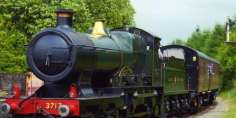 From the Ice Age
drawings at
Creswell Crags, a perfectly preserved snapshot of a typical 1920s home at
Mr Straw’s House in Worksop, to the magnificent Elizabethan mansion that is
Wollaton Hall, or to wonderful
Hardwick Hall,
Nottinghamshire is crammed with historical attractions. From the Ice Age
drawings at
Creswell Crags, a perfectly preserved snapshot of a typical 1920s home at
Mr Straw’s House in Worksop, to the magnificent Elizabethan mansion that is
Wollaton Hall, or to wonderful
Hardwick Hall,
Nottinghamshire is crammed with historical attractions.
Experience fun and engaging heritage at the
Galleries of Justice Museum,
the City of Caves and the
Great Central (Heritage) Railway - which is
actually scheduled to be running on the Friday and Saturday of the weekend of the conference. Explore the
pretty village of
Edwinstowe, supposedly the place where Robin Hood and Maid Marian tied the
knot. Or venture into Laxton,
the only village in England that still operates traditional open field farming.
There are lots of opportunities to experience something totally new. With a
whole host of trails around the city and county, exploring the local heritage
doesn't have to cost the earth!
More information will be
provided as we hear of reactions to the Conference. Keep coming back to get updates.
|
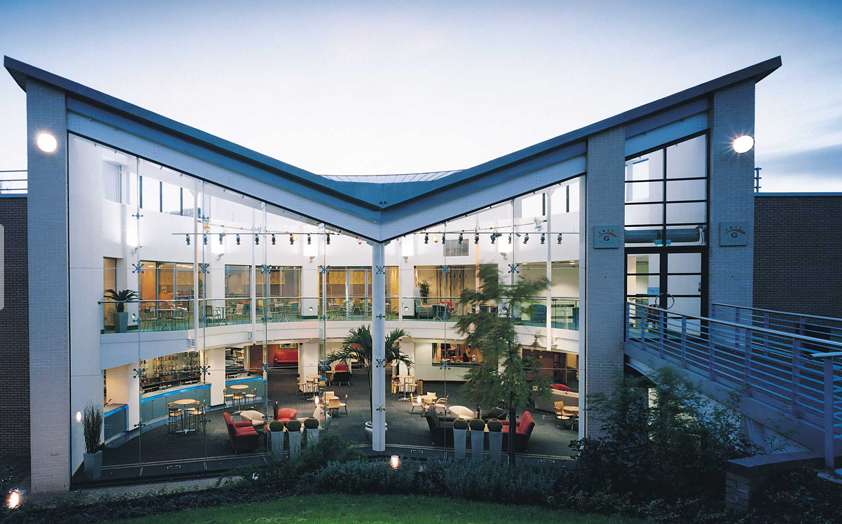
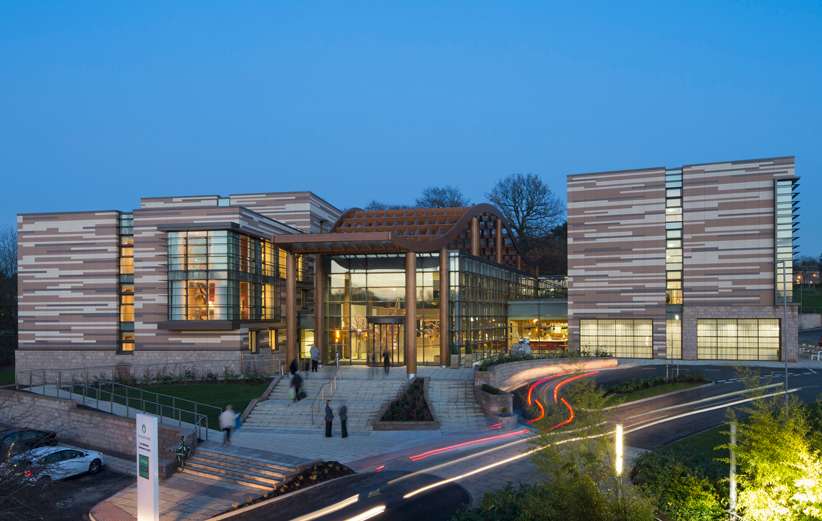

 At
the 2015 Conference Christopher Daniel showed delegates a proof copy of
his new book. This is a compilation of all of his many contributions
to the 'Sundial Page' feature of Clocks Magazine that had
originally been started by Noel Ta'Bois.
At
the 2015 Conference Christopher Daniel showed delegates a proof copy of
his new book. This is a compilation of all of his many contributions
to the 'Sundial Page' feature of Clocks Magazine that had
originally been started by Noel Ta'Bois.




 bowl
that is so
much a part of an original P&G dial. It is mounted on an 18thC pedestal. When it
was made it included an Equation of Time cam of somewhat doubtful accuracy and this was compounded by
it being fitted out of phase with the date selection,
so that if the month
of November was selected (for example) then the adjustment for February was applied, so the
inherent November ‘fastness’ was augmented and the dial read 16 mins fast, PLUS
14 Mins! Up until that time the then Bromley staff had believed that the dial had
always worked and told perfect time just as per a clock, though we now know that was not so. In his restoration, Graham Aldred remounted the existing cam so that its
adjustments were aligned with the date, but even then the cam itself was not
sufficiently accurately made. The dial therefore now remains as one with a small
'repaired fundamental error'
in its construction and one which has been restored to the best working state
achievable by its existing components. It is set accurately on the meridian.
Have a look and see for yourself just how accurate it really is. There is
some more information about (original) Pilkington and Gibbs Heliochronometers, courtesy of
BSS Member Mike Shaw,
bowl
that is so
much a part of an original P&G dial. It is mounted on an 18thC pedestal. When it
was made it included an Equation of Time cam of somewhat doubtful accuracy and this was compounded by
it being fitted out of phase with the date selection,
so that if the month
of November was selected (for example) then the adjustment for February was applied, so the
inherent November ‘fastness’ was augmented and the dial read 16 mins fast, PLUS
14 Mins! Up until that time the then Bromley staff had believed that the dial had
always worked and told perfect time just as per a clock, though we now know that was not so. In his restoration, Graham Aldred remounted the existing cam so that its
adjustments were aligned with the date, but even then the cam itself was not
sufficiently accurately made. The dial therefore now remains as one with a small
'repaired fundamental error'
in its construction and one which has been restored to the best working state
achievable by its existing components. It is set accurately on the meridian.
Have a look and see for yourself just how accurate it really is. There is
some more information about (original) Pilkington and Gibbs Heliochronometers, courtesy of
BSS Member Mike Shaw,

 Another sundial exists in Nottingham itself. This is an
horizontal dial and is actually on the University campus, only a short walk from
the Conference.
Another sundial exists in Nottingham itself. This is an
horizontal dial and is actually on the University campus, only a short walk from
the Conference.  From the Ice Age
drawings at
From the Ice Age
drawings at